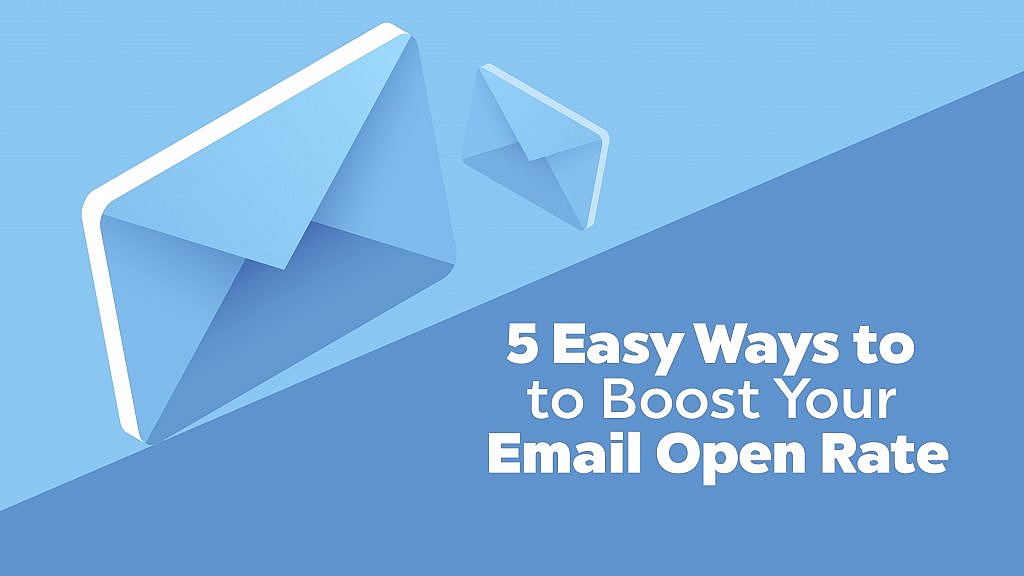5 Easy Ways to Boost Your Email Open Rate
As an email marketer, your no. 1 goal is to boost your open rates and get people to click through that awesome content you create. While good copywriting techniques will help, there are other things you can do to get your emails in front of more eyeballs. The great news is that these things are so easy to implement that you’ll want to get to work today.
Let’s dive in!
Remove invalid email addresses
This may sound like a no-brainer, but still, there are marketers out there who continue to email invalid addresses. Although they bounce, some senders believe it’s no big deal, since everyone else is getting their emails. But that’s not how email marketing works.
When you get lots of bounces, your sender reputation starts to decline. Internet Service Providers (ISPs) look at you and see someone who doesn’t care about best practices. As a result, they’ll start delivering your emails in people’s spam folder. Even worse, you may end up on a blacklist and be banned from sending any email at all.
So, what to do? Before sending your next email, prune out all the invalid addresses from your list. It’s fast and easy – use an email list verification service and it’ll do the job within minutes.
Are you getting spam complaints?
You work hard to come up with the most engaging emails for your audience. But at some point, you’re going to get a spam complaint. Either the person forgot they ever subscribed to your emails, or they find your content to be spammy – it’s just going to happen.
What’s important is for you to stay on top of your spam complaints, because they’re a real risk to your sender reputation. As soon as you notice a subscriber labeling your message as spam, remove that person from your list. They clearly don’t want to hear from you, so let them go.
Also, if you want to protect your reputation, you can prevent known complainers from getting on your list in the first place. By installing an email validation API, you’ll keep your database free of abuse emails. The API checks every email address in real time and rejects the bad ones automatically – so you get to maintain good email hygiene at all times.
Let go of role-based email addresses
They’re necessary – especially to larger companies – but they have very little value to your email marketing. You’ll recognize them easily: contact@, office@ or @team@ are email addresses usually monitored by a group of people, not a single person.
Why do they sabotage your open rates?
- They get so much email that whoever checks them tends to delete messages en masse. Your chances to sell anything are slim.
- Because of the volume of email they receive, they’re prone to soft bounces (as mailboxes get full)
- Because your emails are at a risk of getting deleted or archived without being open, role-based accounts affect your overall engagement. That, in turn, will have a negative impact on your sender reputation.
Ideally, you would only communicate with people who want to receive content from you, and role-based accounts are not among them.
Inactive subscribers: should you keep them?
In a nutshell: no. As you’ve seen earlier, your engagement metrics have a significant influence on your sender reputation.
When people open your emails and click through your content, they’re showing ISPs that you’re doing a good job at email marketing. On the other hand, low open and click rates are a clear indication that people don’t care so much about what you send them. So, you’ll land in the junk pile or in Google’s Promotions tab.
Subscribers who never engage with your content aren’t doing you any service. As hard as it may be, say goodbye to them and move on.
When should you do that? The ideal frequency is every six months. If someone hasn’t clicked on anything you’ve sent in more than half a year, chances are they’re a lost cause.
Test your subject lines
They’re crucial to your open rates: 47% of people open emails based on the subject line alone. So how can you make your subject lines more compelling?
Uwe Dreissigacker, founder and CEO of InvoiceBerry, shared one of his team’s rules when it comes to subject lines. “We never write them in title case. Instead, we use sentence case to make our emails look like they’re coming from someone familiar,” Uwe said. It makes sense: when you get an email from a friend, the subject line is never in title case, right?
Apart from that, consider writing down several subject lines before you choose a winner. It will force you to get creative and come up with more ideas – and more ideas are always better than one.
Finally, you can test your subject lines. Split your list and use different subjects for each segment. In a couple of days, check your reports and see which one performed best. Then, use that insight to boost your open rates in the long run.
Let’s wrap up: how to increase your email open rates
- Start with a clean email list: use an email verification system periodically to weed out bad contacts.
- Break up with people who mark you as spam: you’ll probably never win them back.
- Avoid emailing role-based email addresses: they only eat up your email marketing budget without bringing you anything in return.
- Let go of subscribers who haven’t engaged with your content in more than six months.
- Test your subject lines and use the sentence case as opposed to the title case.
Increasing your open rates can take time, so be patient. Email your list consistently and send out the best content you can produce. In time, your subscribers will become more familiar with your brand and that helps you build trust and steady results.
